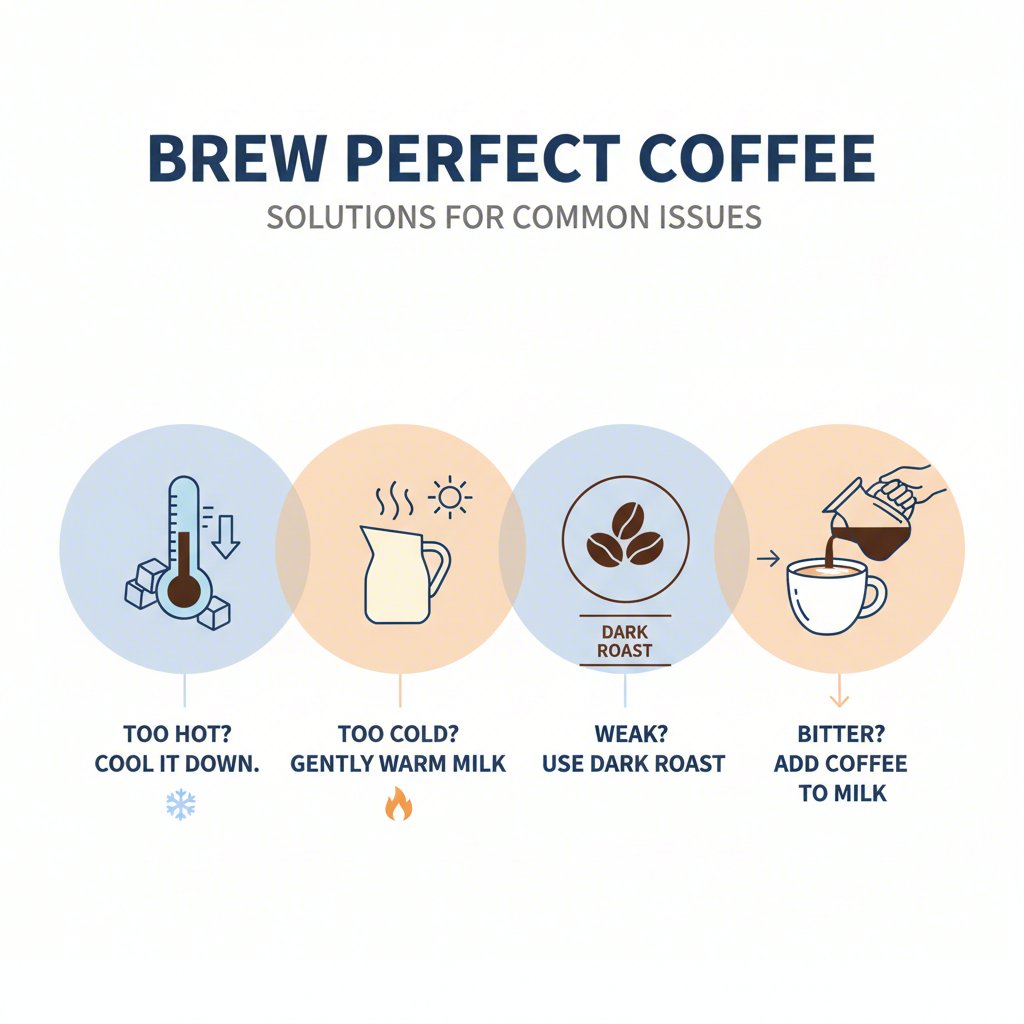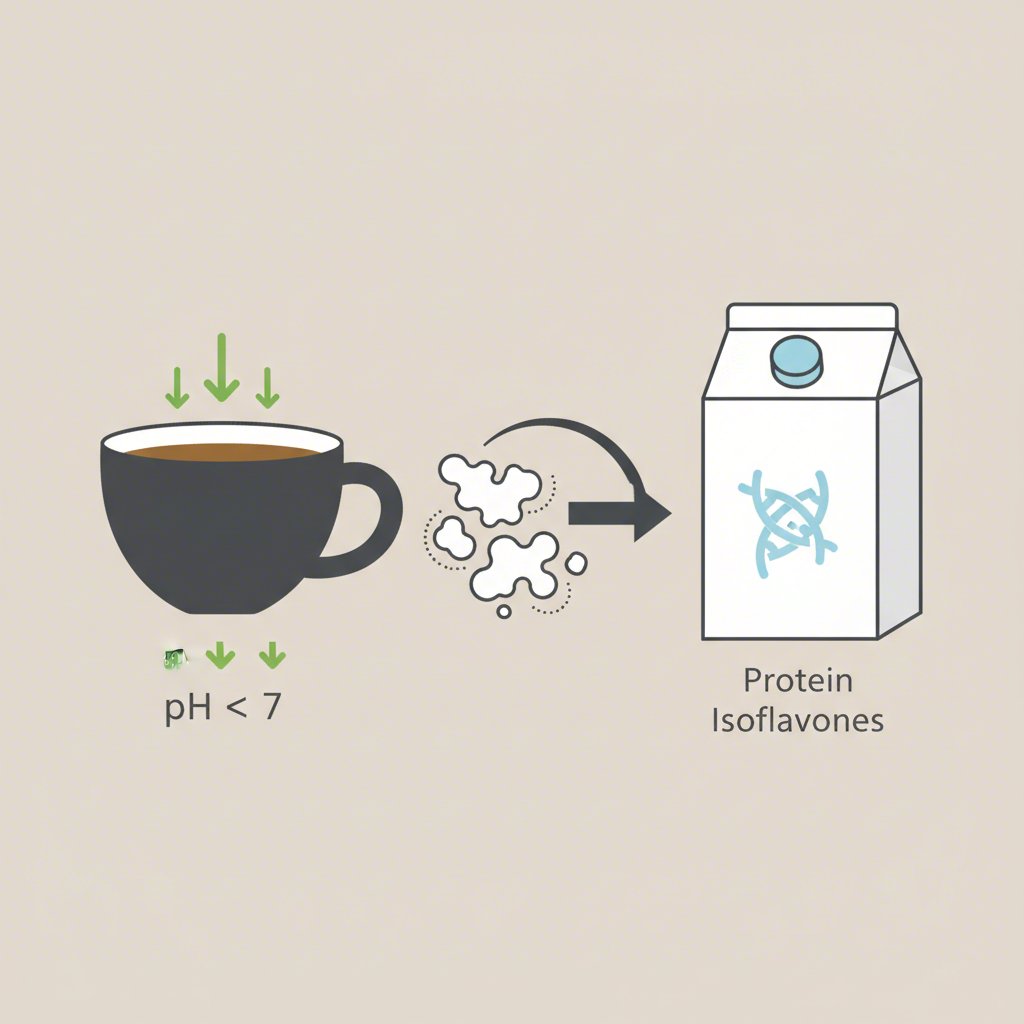TL;DR
Soy milk curdles in coffee due to a perfect storm of chemistry involving high acidity and high temperature. Coffee is naturally acidic, which causes the proteins in soy milk to denature and clump together. The heat from your hot coffee acts as a catalyst, speeding up this reaction and creating the lumpy texture you see in your cup. Preventing this involves managing either the coffee’s acidity or the temperature difference between the two liquids.
The Science of Curdling: Why Acidity and Temperature Matter
Finding clumps floating in your morning coffee can be frustrating, but the reason your soy milk curdles is based on simple science. The phenomenon is primarily caused by two key factors: the acidity of your coffee and the temperature shock when the two liquids combine. Understanding this process is the first step toward achieving a perfectly smooth, creamy cup every time.
Coffee is a naturally acidic beverage, typically having a pH level between 4.5 and 5. In contrast, soy milk is closer to neutral. As detailed in an article from Medium, the proteins in soy milk are stable until the pH drops to around 5.5, which is its ‘curdle point’. When you pour soy milk into acidic coffee, the pH of the milk drops, causing its proteins to lose their structure and coagulate, or clump together. This process is known as denaturation.
Heat acts as an accelerator for this chemical reaction. When cold soy milk is poured into a steaming cup of coffee, the sudden temperature increase provides the energy needed for the proteins to curdle almost instantly. This is why the problem is more common in hot coffee than in iced coffee. Interestingly, the process is very similar to how tofu is made, where a coagulant is intentionally added to heated soy milk to separate the curds from the whey.
You might wonder why this doesn’t typically happen when you add soy milk to tea. The answer lies in acidity. Most teas are significantly less acidic than coffee, meaning they don’t lower the soy milk’s pH enough to trigger the curdling reaction. Unless you add an acidic ingredient like lemon, your soy milk is likely to remain smooth in a cup of tea.

Practical Methods to Prevent a Curdled Cup
Now that you understand the science, preventing soy milk from curdling is a matter of controlling the variables of temperature and acidity. Fortunately, there are several easy and effective methods you can try, ranging from simple technique adjustments to more strategic choices in your ingredients. Here are some of the most reliable ways to ensure a smooth cup.
First, managing the temperature difference is crucial. One of the simplest solutions is to let your coffee cool slightly for a minute or two before adding the soy milk. Lowering the coffee’s temperature reduces the thermal shock, giving the milk proteins less energy to curdle. Alternatively, you can gently warm your soy milk before adding it to the coffee. This minimizes the temperature gap from the other direction and is a common technique used by baristas.
The order in which you combine the ingredients also makes a difference. Try pouring the coffee slowly into the soy milk, rather than the other way around. This allows the milk to heat up more gradually, reducing the likelihood of a sudden reaction. A barista pro-tip shared by BeanScene Magazine involves pouring a small amount of soy milk into the espresso and swirling it to acclimate the liquids before adding the rest.
Controlling acidity is another effective strategy. You can start by choosing low-acidity coffee beans. As noted by the Kent & Sussex Tea and Coffee Company, dark roasts and Arabica beans grown in regions like South America tend to be less acidic than light roasts or Robusta beans. For a more direct approach, adding a tiny, almost imperceptible pinch of baking soda to your coffee grounds before brewing can help neutralize some of the acid. Finally, always make sure your soy milk is fresh and shake the carton well before use, as older milk can be more prone to separating.
Does Your Choice of Coffee and Soy Milk Matter?
Beyond technique, the specific products you choose can have a significant impact on whether your soy milk curdles. Not all soy milks or coffee beans are created equal, and making informed choices at the grocery store can be one of your best defenses against a lumpy latte.
Many coffee shops rely on “barista edition” plant milks for a reason. These products are specifically formulated to perform well in hot, acidic environments like coffee. They often contain small amounts of acidity regulators, such as potassium phosphate or calcium carbonate, which act as buffers to prevent the proteins from curdling. While they may be slightly more expensive and have a longer ingredient list, they offer a nearly foolproof way to get a smooth, creamy texture every time.
In contrast, organic or homemade soy milks often lack these stabilizers, making them much more sensitive to heat and acidity. For those who prefer full control over ingredients, making fresh, additive-free plant-based milks at home is a great option. If you’re exploring this route, Soy Milk Quick offers an expert guide to the best plant milk makers for every need, with detailed comparisons to help you find the perfect machine for creating delicious homemade almond, oat, or soy milk.
On the coffee side, the roast and origin play a major role. As a general rule, darker roasts are less acidic than lighter roasts. Roasts like French, Italian, or Espresso will typically be more forgiving with soy milk. Coffee beans from certain regions, like Brazil or Sumatra, are also known for their lower acidity compared to beans from Africa, which are often prized for their bright, acidic notes. Experimenting with different beans can help you find a perfect pairing for your favorite soy milk.

Is Curdled Soy Milk Safe to Drink?
Seeing your coffee curdle can be unappetizing, and it’s natural to wonder if it’s still safe to drink. The short and reassuring answer is yes, it is perfectly safe. The curdling you see is a purely chemical reaction between the soy proteins and the coffee’s acid and heat, not a sign of spoilage or harmful bacterial growth.
Think of it as a mini science experiment in your mug. The clumps are simply coagulated soy proteins, similar to the curds that form when making cheese or tofu. While the texture might be unpleasant, it poses no health risk. The taste may be slightly more acidic or bitter than you’re used to, but the coffee itself has not gone bad.
It is important, however, to distinguish this type of curdling from spoilage. If your soy milk smells sour or has clumps in the carton *before* you add it to your coffee, it has likely spoiled and should be discarded. Your sense of smell is the best guide here. If the milk smells fine on its own and only curdles upon contact with hot coffee, you can drink it without concern, even if you decide to brew a new, smoother cup for a better experience.
Frequently Asked Questions
1. Is curdled soy milk in coffee safe to drink?
Yes, soy milk that curdles in coffee is completely safe to drink. The curdling is a chemical reaction to the coffee’s heat and acidity and is not a sign of spoilage. While the texture may be unappealing, it is not harmful.
2. How can you fix coffee that already has curdled milk?
Unfortunately, once soy milk has curdled, it’s very difficult to reverse the process completely. Vigorous stirring might temporarily break up the clumps, but they will likely reform. The best approach is to prevent it from happening in the first place by using the methods described above, such as letting the coffee cool slightly or warming the milk first.
3. Is it generally okay to mix coffee and soy milk?
Absolutely. Soy milk is a popular and delicious dairy-free alternative for coffee. When combined correctly to avoid curdling, it creates a rich, creamy beverage. Many people enjoy the nutty flavor it adds to both hot and iced coffee drinks.
